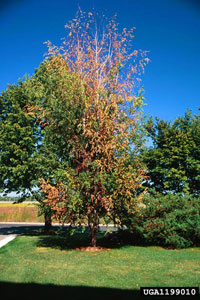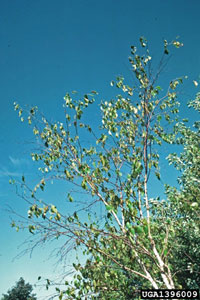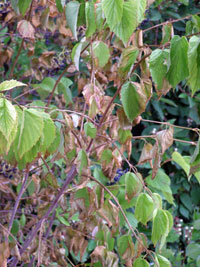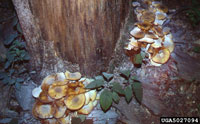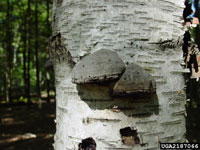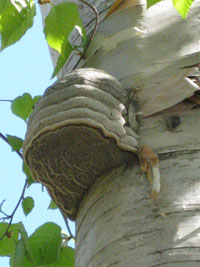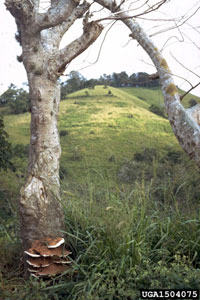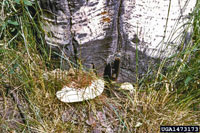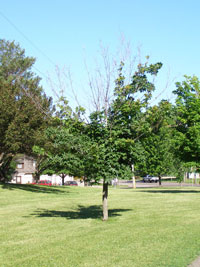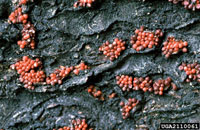Extension > Garden > Diagnose a problem > What's wrong with my plant? > Deciduous Trees > Birch > Dead branches in canopy
Birch > Trunk/Branches > Dead branches in canopy
1 of 5
Bronze birch borer
Agrilus anxius
- Eventually twigs and then branches dieback starting at the
top of the canopy and progressively working its way down - Foliage at top of the canopy first becomes sparse
- Raised lumps or ridges can be seen on the trunk and branches
- D-shaped exit holes can eventually be observed on the trunk
and branches - S-shaped galleries can be seen under the bark
- Preferred hosts are European white birch and whitebarked Himalayan birch; paper birch, gray birch are also attacked; river birch is rarely infested
- More information on Bronze birch borer
2 of 5
Armillaria root rot
Armillaria spp.
- Infected trees have poor growth, dead branches in the upper canopy, undersized and/or yellow leaves
- Flat white sheets of fungal growth (mycelia fans) grow between the bark and sapwood at the base of infected trees
- Thick black, shoestring-like fungus can sometimes be seen under the bark, around roots and in the soil around the base of the tree
- Wood is decayed, white, soft and spongy, and this may extend from the base of the tree well up into the trunk
- Clusters of honey-colored mushrooms may grow at the base of the tree in fall
- More information on Armillaria root rot
3 of 5
Heart rot
Polyporus squamosus, Laetiporus sulphureus, Fomes
fomentarius, Phellinus igniarius, Piptoporus betulinus
- Canopy may show no symptoms, or may have small yellowing leaves or dead branches depending on the extent of the decay
- In cross section of the trunk, the wood at the center is discolored, soft, crumbling, stringy or spongy
- Fungal fruiting bodies arise along the stem; often near a pruning wound, crack or other wound
- Many colors, shapes and sizes of fruiting bodies may be seen
- More information on heart rot
4 of 5
Ganoderma root and butt rot
(artist's conk)
Ganoderma applanatum
- Canopy appears thin with few leaves and multiple dead branches
- Leaves are smaller in size and turn yellow earlier than normal
- Fungal conks, a semicircle shelf fungi, can be found from the base of the tree up to 3 feet high on the trunk
- Conks are reddish-brown and shiny on top, white and porous underneath; a rim of white may be visible on the edge of
growing conks - Infected wood at the base of the tree is white, soft, stringy
or spongy - Infected trees frequently break or fall over in storms
- More information on Ganoderma butt rot
5 of 5
Coral spot canker
Nectria cinnabarina
- Dead branches and twigs are often first observed in early spring
- Sunken dark brown area on branch that is often cracked or has a ridge at the edge
- Raised cushion-like bumps on affected branches, may be cream
to orange or red, turn black with age - Common on trees stressed by drought, recent transplant or
other factors - More information on canker



